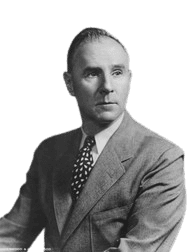Life and achievements
Early life
Norman Levi Bowen was born on June 21, 1887, in Kingston, Ontario, Canada. He had a good foundation in science, especially chemistry and geology, in his early years at Queen’s University in Ontario. Bowen obtained his first degree in geology and mineralogy in 1909 and then continued to get his master’s degree at the same university in 1910. His academic achievement and passion for the Earth's physical processes made him continue his studies at the Massachusetts Institute of Technology (MIT), where he was conferred with a PhD in 1912. Bowen’s time at MIT was significant for his further development as a scientist since he got involved in experimental research on the recrystallization of minerals from the melt of rock, which defined the course of his work.
After finishing his doctorate, Bowen joined the Geophysical Laboratory of the Carnegie Institution for Science in Washington, D. C. Here, Bowen worked under the supervision of leading geologists and chemists and conducted his first significant research in phase equilibria in silicate systems, which is the foundation of his most important work. His work on the physical properties of minerals, especially as they relate to the cooling of magma, made him one of the most promising petrologists of his time. At the age of 28, Bowen released The Later Stages of the Evolution of the Igneous Rocks (1915). This paper presented a new concept of igneous rock formation through fractional recrystallization based on physicochemical principles.
His passion for recrystallization silicates made him develop Bowen’s Reaction Series in the early 1920s. He described how minerals form from cooling magma and gave a step-by-step process of how minerals form based on temperature. The reaction series is divided into two branches: The first one is the discontinuous branch, which consists of minerals that alter their structure with the progress of cooling. The second is the continuous branch, in which the minerals remain chemically the same, but the composition may vary. This model has been instrumental in changing the way geologists thought about the formation of igneous rocks and has been used in geology up to the present.
Legacy
Norman L. Bowen’s contribution to petrology is still felt today and is diverse. His contribution helped scientists change how they research and analyze the formation of igneous rocks, primarily through Bowen’s Reaction Series. This model helped to explain how various types of igneous rocks, such as basalt, granite, and andesite, are formed from the cooling of magma. Bowen’s approach was not simply descriptive; it was based on experimental work that generated numerical data regarding the physicochemical processes of rock formation. His experimental methods provided a new approach to petrology, which focused on the controlled laboratory work in conjunction with the field study.
Bowen’s work also affected the entire field of geochemistry. Considering temperature, pressure, and the chemistry of mineral recrystallization opened the way for further studies of the chemical evolution of the Earth’s crust. In subsequent years, many geologists followed his methods of experimentation, which helped in the better understanding of not only the igneous rocks but also the formation of metamorphic and sedimentary rocks. Bowen’s work at the Geophysical Laboratory allowed him to train scientists researching the relationship between chemistry and geology.
Besides, Bowen was awarded and honoured by the international scientific community for his scientific contributions. He was also honoured with the Bigsby Medal of the Geological Society of London in 1931, the Penrose Medal of the Geological Society of America in 1941, and the Roebling Medal of the Mineralogical Society of America in 1950. Bowen was also elected to the Royal Society as a Foreign Member in 1949, one of the world's most prestigious societies. His work spread across the global stage, and his concepts were integrated into other global geological surveys.
After retiring from the Geophysical Laboratory in 1952, Bowen’s work did not cease. His influence was also continued by creating the Norman L. Bowen Award, which the American Geophysical Union awards yearly for significant achievements in volcanology, geochemistry, and petrology. Bowen’s name has also been engraved on a lunar crater, which is a testimony to his contribution to the scientific society.
Milestone moments
Jun 21, 1887
Norman L. Bowen’s Birth.
Norman Levi Bowen was born on June 21, 1887, in Kingston, Ontario, Canada.
His passion for geology and mineralogy developed at Queen’s University, where he received a solid academic foundation.
Bowen was always fond of chemistry and physics at an early age, and these two subjects would be vital in his later studies.
May 15, 1915
Publication of The Later Stages of the Evolution of the Igneous Rocks
In 1915, at the age of 28, Bowen published The Later Stages of the Evolution of the Igneous Rocks, a quantitative physicochemical account of the formation of igneous rocks.
For the first time, this paper presented the idea of fractional recrystallization, where different minerals recrystallize from magma at various temperatures to form different igneous rocks.
Apr 16, 1928
Publication of The Evolution of the Igneous Rocks
Bowen’s book, The Evolution of the Igneous Rocks, published in 1928, became a reference material in petrology and crystallization theory.
The book was based on a series of lectures he delivered at Princeton University in 1927.
Nov 7, 1947
A professorship at the University of Chicago
Between 1937 and 1947, Bowen was appointed the Charles H. Hutchinson Distinguished Service Professor of Petrology at the University of Chicago.
In this decade, Bowen supervised a school of experimental petrology that generated a large body of work on the recrystallization of alkali minerals.
